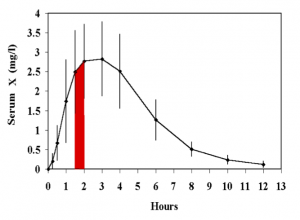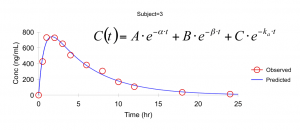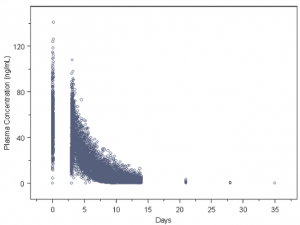Pharmacokinetic analysis is often broken into two areas … “PK” and “population PK”. Sometimes the first term “PK” is also called “individual PK”. I’d like to demystify these two analysis methods in this post. In the analysis of biological samples, we have many different detection technologies, for example mass spectroscopy, UV spectroscopy, radiometric detection, and immunochemistry. Each of these technologies is useful, with none being “better” than any other. They are simply tools that can be used for different types of analysis. Individual PK and population PK are simply two different analysis techniques that we use in pharmacokinetic data analysis.

Individual PK-Noncompartmental Analysis
Individual PK usually has the following features:
- Noncompartmental methods
- Use graphical techniques
- Used for Phase I studies
- Not useful for predictive work
- Requires intensive sampling
- Analysis time is short
- Can determine
- Maximum exposure (Cmax)
- Total exposure (Area under the curve or AUC)
- Clearance
- Bioavailability
- Volume of distribution
- Terminal half-life (t1/2)
If the data from the individual PK profiles are adequate, the data can be fit to an model. Compartmental fits on individual data have the following features:

Individual PK – Compartmental Fit
- Compartmental analysis uses exponential equations to describe the curve
- Accomplished by using theoretical “compartments” and the transfer rates between these compartments.
- Can be used for simulations (limited possibilities)
- Can determine: Clearance, bioavailability, volume of distribution, absorption rate, distribution profile, metabolic fate/conversion, terminal half-life (t1/2)
If however, you want to understand how individuals from a population differ from one another, you will need to perform population PK analysis. In this type of analysis, all data from all individuals is considered at the same time in a unified model. Population PK analysis has the following features:

Population PK
- Evaluates entire population
- Can be used for predictions and simulations
- Computationally intensive
- Intensive and sparse sampling
- Analysis time is longer
- PK/PD modeling (relationship between drug levels and drug effects)
- Can determine
- Clearance
- Volume of distribution
- Effect of covariates (e.g. age, weight, sex, kidney function)
| Individual PK | Population PK |
|---|---|
| Advantages | Advantages |
|
|
| Disadvantages | Disadvantages |
|
|
Systems with distributed delays are extensions of systems with discrete delays where a single lag time is represented by a distribution of lag times. Distributed absorption times for orally administered drugs serve as an example of a pharmacokinetic (PK) system with distributed delays. Another example is a hematopoietic cell population with distributed lifespans.
Watch this webinar to learn how Certara’s population PK/PD software, Phoenix NLME, can be used to model pharmacokinetic/pharmacodynamic (PK/PD) systems with distributed delays.


